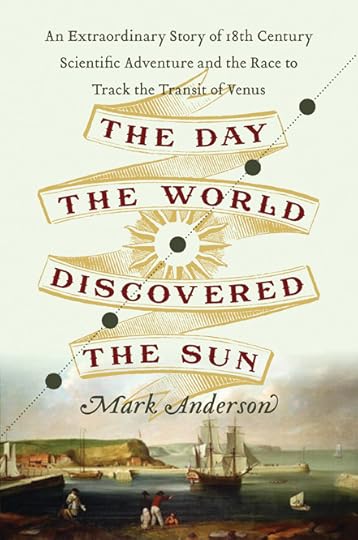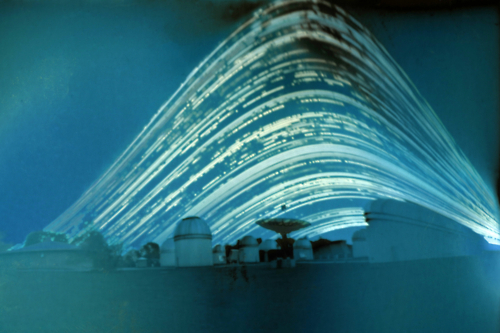Mark Anderson's Blog, page 5
February 29, 2012
"Who knew that the 18th century’s race to observe the transit of Venus across the sun could be..."
- Michael Prescott, best-selling author of Final Sins
"Who knew that the 18th century's race to observe the transit of Venus across the sun could be..."
- Michael Prescott, best-selling author of Final Sins
"THE DAY THE WORLD DISCOVERED THE SUN is a real pleasure to read—blending tales of tenacity and..."
- Peter Eisner, former deputy foreign editor at The Washington Post, author of The Italian Letter & The Freedom Line
"THE DAY THE WORLD DISCOVERED THE SUN begins with a little dot—which we discover is the planet..."
- Lee Gutkind, founding editor, Creative Nonfiction; author, You Can't Make This Stuff Up
February 1, 2012
An excellent video about Venus transits was just posted last...
An excellent video about Venus transits was just posted last week sharing stories about Venus transit observers from centuries past — including Captain James Cook (who sailed to Tahiti to observe the 1769 transit) and the team of Charles Mason and Jeremiah Dixon (who observed the 1761 transit from Cape Town, South Africa before becoming household names surveying a famous borderline between Maryland and Pennsylvania).
The video also contains some tips for observing Venus in transit in June. It contains a serious reminder, too: Never look directly at the sun using a telescope or binoculars. If you have a solar filter on your device (something that looks like a sheet of tinfoil covering the front of the scope), that's another matter. But this warning is really important. Looking directly at the sun, especially through anything that magnifies the sun's light like a telescope or binoculars, can cause severe and permanent eye damage.
(Tip of the hat to transitofvenus.nl)
January 31, 2012
Proud to be able to unveil today the official book cover!

Proud to be able to unveil today the official book cover!
January 29, 2012
Here’s the video from the previous post.
Here’s the video from the previous post.
Here's the video from the previous post.
Here's the video from the previous post.
Aurora - when the sun hits home (video)
In 1769, the Hungarian Jesuit adventurers Maximilian Hell and Johanes Sajnovics traveled to northernmost Norway, above the arctic circle, to observe the transit of Venus.
They spent a cold and dark winter of 1768-'69 at their destination, Vardø, making detailed observations of the aurora (and other natural phenomena). One theory at the time was that these "Polar Lights," as they were called then, were ice crystals in the sky illuminated by the sun.
Today we know they're caused by charged particles from the sun spiraling around the earth's magnetic field and giving off a haunting glow in the process.
Hell and Sajnovics never reached any firm conclusions about the aurorae — although that didn't stop the egotistical Hell from denouncing others who put forward their own theories.
But they saw, over many nights throughout their stay, some spectacular light shows.
This month, energized by recent violent solar storms, spectacular aurorae have visited northern Norway once again. See the link below for some tremendous HD video footage.
January 21, 2012
This amazing image follows the sun's path every day over...

This amazing image follows the sun's path every day over the course of a half-year, from June 21 to December 21. Each upside down "V" is a trace of the sun as it travels from sunrise to sunset. On June 21, the Summer Solstice, the longest day of the year, that upside-down "V" is the highest solar arc in the picture. Every successive day after that is slightly lower than the one before it. Till you get to the shortest day of the year, Dec. 21.
Here is the photographer's description. (From NASA's "Astronomy photograph of the day")
From solstice to solstice, this six month long exposure compresses time from the 21st of June till the 21st of December, 2011, into a single point of view. Dubbed a solargraph, the unconventional picture was recorded with a pinhole camera made from a drink can lined with a piece of photographic paper. Fixed to a single spot for the entire exposure, the simple camera continuously records the Sun's path each day as a glowing trail burned into the photosensitive paper. In this case, the spot was chosen to look out over the domes and radio telescope of the University of Hertfordshire's Bayfordbury Observatory. Dark gaps in the daily arcs are caused by cloud cover, whereas continuous bright tracks record glorious spells of sunny weather. Of course, in June, the Sun trails begin higher at the northern hemisphere's summer solstice. The trails sink lower in the sky as December's winter solstice approaches. Last year's autumn was one of the balmiest on record in the UK, as the many bright arcs in the lower part of this picture testify.



